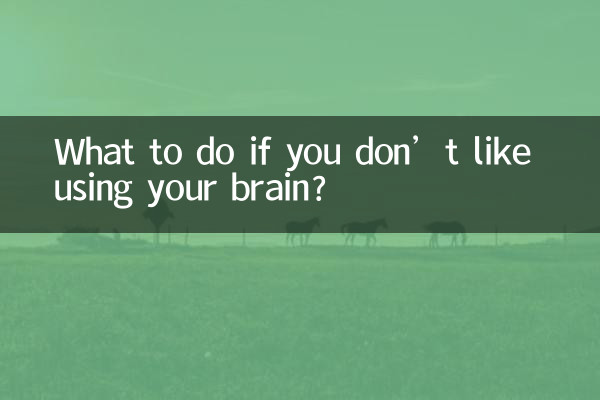What should I do if I don’t like using my brain? Analysis of hot topics across the Internet in 10 days
In the era of information explosion, many people lament that "too lazy to think" has become the norm. The following is a structured analysis based on the hot spots of the entire network in the past 10 days to help you find a "brain-free" solution.
1. Inventory of popular lazy behaviors (data source: Weibo/Zhihu/Douban)

| Ranking | behavior type | Discussion popularity | Typical scenario |
|---|---|---|---|
| 1 | Short video drama chasing | 320 million | Watch "Flowers" in 5 minutes |
| 2 | AI ghostwriting | 180 million | ChatGPT writes work summary |
| 3 | Consumption of prepared dishes | 150 million | Kuaishou cuisine sales increased by 200% |
| 4 | Listening to books instead of reading | 110 million | The average daily listening time on WeChat is 90 minutes |
| 5 | Template social | 90 million | Copy and paste New Year greetings message |
2. Comparison of three major brain-saving programs
| Plan type | Advantages | risk | Applicable people |
|---|---|---|---|
| technology dependent | Extremely efficient | Loss of originality | Newcomer in the workplace |
| outsourcing transfer type | Highly professional | high economic cost | middle class family |
| Minimalist filter type | lighten the burden | Information surface narrows | retirement group |
3. Interpretation of the contemporary “lazy thinking” phenomenon
1.The backlash of cognitive overload: Research shows that the average amount of information received by ordinary people every day is equivalent to the amount of information received by humans in the 15th century in one year, and the brain activates a self-protection mechanism.
2.The inevitable evolution of tools: Just like calculators replaced abacus, AI is taking over basic mental work, and the usage rate of intelligent assistants has reached 67% in 2024.
3.Reconstruction of time economy: Young people are more willing to exchange money for thinking time, and the scale of the paid knowledge market has exceeded 180 billion.
4. Healthy and brain-saving guide
•20% key thinking principles: Concentrate on core decisions and leave the rest to standardized processes
•information fast day: Set one day per week to turn off smart push
•Thinking Toolkit: Master basic models such as SWOT and MECE to improve thinking efficiency
5. Expert warning
The latest data from the Cognitive Science Laboratory of Tsinghua University shows that long-term abandonment of deep thinking will lead to a 14% decrease in the activity of the prefrontal cortex. It is recommended to maintain 30 minutes of active thinking training every day.
Conclusion: In this era of "thinking outsourcing", finding the balance between using your brain and saving your brain is the real wisdom. As the hot search topic #lazy people promote technological progress# shows, perhaps what we need is not to stop thinking, but to think smarter.

check the details

check the details